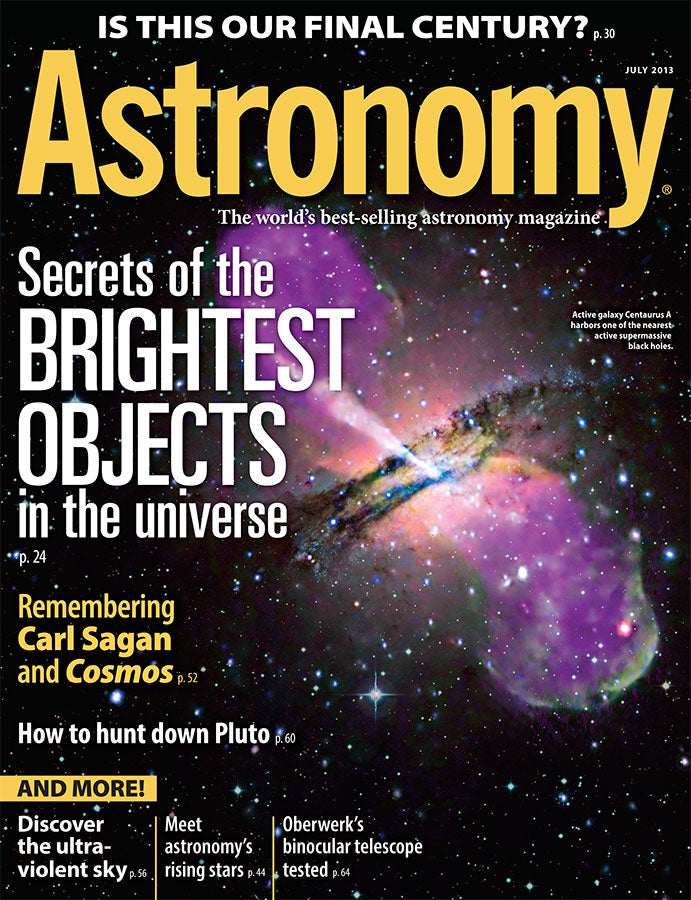
Waukesha, Wis. – In the 1960s, scientists discovered quasars – the bright centers of active galaxies – and learned that these objects lie more than 1 billion light-years from Earth. In the 50 years since, they’ve found that supermassive black holes power quasars along with other types of “active galactic nuclei.”
In “Secrets of the brightest objects in the universe,” Associate Editor Liz Kruesi explains how scientists study the light from quasars to piece together the structure of a supermassive black hole’s environment – such as how material is arranged and how it moves. Quasars also were more prolific in earlier cosmic epochs. “So by studying bright quasars from different distances, and thus different times of the universe,” writes Kruesi, “scientists can learn how galaxies evolve.” This means astronomers also can use the light to learn about intervening material between a quasar and Earth. This is just a sample of the types of information astronomers can glean from these active galactic nuclei.
Learn more about these extreme objects in the July 2013 issue of Astronomy magazine, on newsstands June 4.
“Remembering Carl Sagan and Cosmos“
In “Remembering Carl Sagan and Cosmos,” Raymond Shubinski writes about the celebrated astronomer and the insanely popular TV series he narrated and co-wrote, which aired in 1978–79. With a total viewership of more than half a billion people, Cosmos did more to excite the public about astronomy and the universe than anything that came before – and set the bar for programs that followed.
“Is this our final century?”
The universe is a dangerous place, as the February 15 Russian meteorite fall proved. But incoming rocks aren’t the only threat to human civilization on Earth. In “Is this our final century,” Britain’s Astronomer Royal, Martin Rees, explores the various ways the cosmos could harm us – from the Sun’s sporadic flaring and further afield exploding stars to bioterror on our planet. But this article isn’t just to scare the reader; Rees also discusses how likely these traumatic events are.
“How to hunt down Pluto”
Whether you call Pluto a dwarf planet, Kuiper Belt object, or argue that it’s still a major planet, locating it can be an incredibly rewarding experience. In “How to hunt down Pluto,” Senior Editor Michael E. Bakich provides tips for observing the magnitude 14 world. This article also includes three finder charts to help in your search.
July 2013 night-sky events visible without optical aid
- July 6 – The Moon passes 4° south of Mars.
- July 21/22 – Venus passes 1.2° north of 1st-magnitude Regulus.
- July 22 – Mars passes 0.8° north of Jupiter before dawn.
- July 30 – The Southern Delta Aquarid meteor shower peaks.
- July 31 – Mercury, Mars, and Jupiter lie within 10° on one another in the eastern sky 45 minutes before sunrise.
Also in the July 2013 Astronomy
- “Astronomy’s rising stars” – From studying our solar system to searching for worlds beyond and seeking answers to the universe’s biggest mysteries, these 10 young scientists could change how we see the cosmos.
- “Discover the ultra-violent sky” – Even a medium-sized telescope will show you objects blowing themselves apart, stealing material from companions, and emitting huge quantities of deadly radiation.
- “Astronomy tests Oberwerk’s 45° 70mm Binocular Telescope” – Superb optics, high-quality workmanship, and interchangeable eyepieces make this product a winner.
- “The Sky this Month” – Exclusive pullout star charts will guide you through the night sky.
- The July issue of Astronomy also includes Astro News, Ask Astro, Snapshot, Breakthrough, Bob Berman’s Strange Universe, Stephen James O’Meara’s Secret Sky, Glenn Chaple’s Observing Basics, Tony Hallas’ Cosmic Imaging, Erika Rix’s Astro Sketching, Cosmic World, Letters, Web Talk, New Products, Reader Gallery, and Final Frontier.









